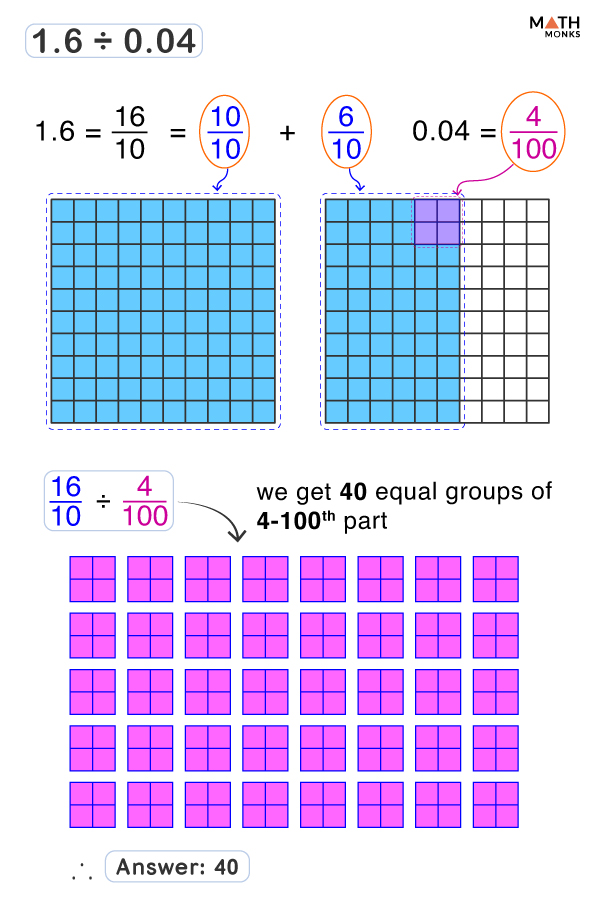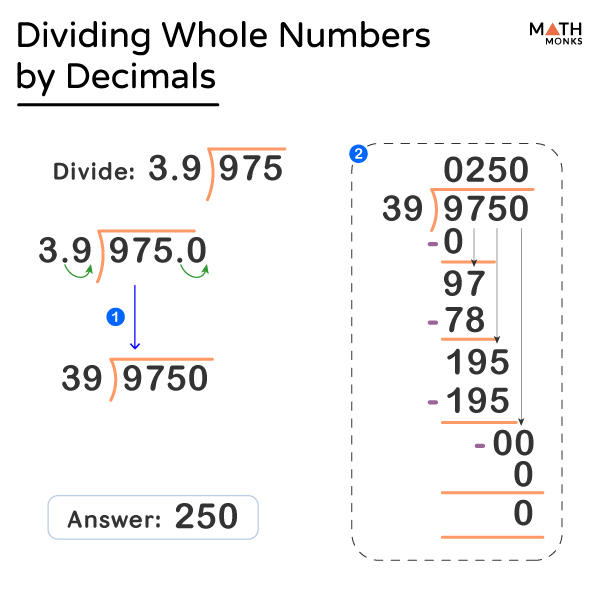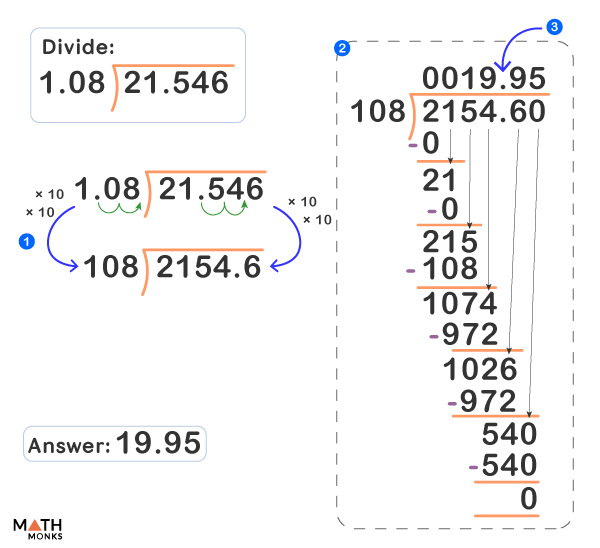How To Divide With A Decimal: The Ultimate Guide For Mastering Decimal Division
Alright, listen up! If you've ever found yourself scratching your head over how to divide with a decimal, you're not alone. Whether you're a student brushing up on math skills or an adult tackling everyday calculations, mastering decimal division is a game-changer. It’s one of those skills that pops up everywhere—in school, at work, or even when splitting dinner bills with friends. So, buckle up because we're about to break it down step by step!
Let’s face it, decimals can feel a little intimidating at first. But don’t worry—we’re here to make this process as smooth as butter. Think of dividing decimals like solving a puzzle; once you know the rules, everything falls into place. This guide will walk you through everything you need to know about dividing decimals, from the basics to some pro tips that’ll make you feel like a math wizard.
Before we dive in, let me just say this: mastering decimal division isn’t just about passing a test. It’s about building confidence in your math skills. And trust me, there’s nothing more satisfying than looking at a tricky decimal problem and thinking, “Yeah, I got this.” So, let’s get started!
Read also:Buying Clothes Online Vs In Store The Ultimate Shopping Showdown
Understanding the Basics of Decimal Division
First things first, let’s talk about what decimals actually are. A decimal is basically a fancy way of writing fractions. For example, 0.5 is the same as 1/2, and 0.25 is the same as 1/4. When it comes to dividing with decimals, the goal is to turn that tricky decimal problem into something simpler—like dividing whole numbers.
Here’s the deal: dividing decimals isn’t all that different from dividing regular numbers. The key is to move the decimal point around until you’ve got whole numbers to work with. Once you’ve done that, it’s smooth sailing. Let’s break it down with an example:
Step 1: Set Up the Problem
Let’s say you’re dividing 12.6 by 0.3. The first thing you need to do is set up the problem properly. Write it out like this: 12.6 ÷ 0.3. Easy enough, right?
Step 2: Move the Decimal Point
Now, here’s where the magic happens. To make this problem easier, you want to get rid of the decimal in the divisor (that’s the 0.3). To do that, move the decimal point one place to the right in both numbers. So, 0.3 becomes 3, and 12.6 becomes 126. Boom! Suddenly, you’re dividing 126 by 3, which is much simpler.
Why Moving the Decimal Works
You might be wondering, “Why does moving the decimal point even work?” Great question! When you move the decimal point, you’re essentially multiplying both numbers by the same power of ten. In our example, moving the decimal one place to the right is the same as multiplying both numbers by 10. Since you’re doing the same thing to both numbers, the result stays the same. Pretty cool, huh?
Let’s look at another example to drive this point home. Say you’re dividing 5.4 by 0.06. Move the decimal point two places to the right in both numbers. That turns 0.06 into 6 and 5.4 into 540. Now you’re dividing 540 by 6, which is way easier to handle.
Read also:Lulu Wide Leg Sweatpants The Ultimate Comfort And Style Combo
Common Mistakes to Avoid
Alright, let’s talk about some common mistakes people make when dividing decimals. First off, don’t forget to move the decimal point in both numbers! It’s easy to get lazy and only move it in one number, but that’ll mess up your answer big time.
Another mistake is misplacing the decimal point in your final answer. Always double-check where the decimal should go. If you’re dividing 12.6 by 0.3 and you end up with 420 instead of 42, something went wrong. Take a second to review your work and make sure everything lines up.
Tip: Use Estimation
Here’s a pro tip: use estimation to check your work. For example, if you’re dividing 12.6 by 0.3, you can estimate that the answer should be around 40. If you end up with something wildly different, like 400 or 4, you know something’s off.
Long Division with Decimals
Now let’s talk about long division with decimals. This is where things can get a little tricky, but don’t worry—we’ve got your back. The process is pretty similar to regular long division, with one extra step: dealing with the decimal point.
Here’s how it works:
- Set up the problem like you normally would for long division.
- Move the decimal point in the divisor (the number you’re dividing by) to make it a whole number.
- Move the decimal point in the dividend (the number you’re dividing) the same number of places.
- Divide as usual, placing the decimal point in your answer directly above where it is in the dividend.
Let’s try an example: divide 8.4 by 0.7. First, move the decimal point one place to the right in both numbers. That turns 0.7 into 7 and 8.4 into 84. Now divide 84 by 7, which gives you 12. Place the decimal point in your answer, and you’ve got 12.0. Easy peasy!
Handling Remainders
Sometimes, when you’re dividing decimals, you’ll end up with a remainder. Don’t panic! Just keep adding zeros to the dividend until you get a clean answer. For example, if you’re dividing 10 by 0.4, you’ll eventually end up with 25. No big deal!
Practical Applications of Decimal Division
Now that you’ve got the basics down, let’s talk about why dividing decimals is so useful in real life. Whether you’re splitting a bill, calculating discounts, or figuring out how much paint you need for a room, decimal division comes in handy all the time.
For example, say you’re buying paint that covers 3.5 square meters per liter, and you need to cover 21 square meters. How many liters of paint do you need? Divide 21 by 3.5, and you’ll find out you need 6 liters. See? Math really does matter!
Dividing Decimals in Business
In the business world, dividing decimals is crucial for calculating profit margins, analyzing data, and making financial projections. For instance, if a company earns $12,600 in revenue and spends $3,600 on expenses, what’s the profit margin? Divide the profit ($9,000) by the revenue ($12,600), and you’ll find it’s about 0.71, or 71%. That’s powerful information for making business decisions.
Advanced Decimal Division Techniques
Ready to take your decimal division skills to the next level? Here are a few advanced techniques to help you tackle even the trickiest problems.
Dividing by Powers of Ten
When you’re dividing by powers of ten (like 10, 100, or 1,000), you can skip the whole moving-decimal-point thing. Instead, just move the decimal point in the dividend to the left by the same number of places as the power of ten. For example, dividing 12.6 by 100 is the same as moving the decimal point two places to the left, giving you 0.126. Simple, right?
Using Estimation for Complex Problems
For really complex problems, estimation can be your best friend. Let’s say you’re dividing 123.45 by 0.003. That’s a lot of decimal places! Start by estimating the answer. Since 123.45 is close to 120 and 0.003 is close to 0.001, you can estimate that the answer should be around 120,000. Now solve the problem using long division, and check your work against your estimate.
Teaching Decimal Division to Kids
Teaching kids how to divide decimals can be a challenge, but with the right approach, it can also be a lot of fun. Start by explaining what decimals are and why they’re useful. Use real-life examples, like splitting pizza or sharing candy, to make the concept relatable.
Then, break the process down step by step. Practice moving the decimal point with simple problems before moving on to more complex ones. And don’t forget to use visual aids, like number lines or grids, to help illustrate the concept.
Making It Fun
Here’s a fun game to try: give your kids a set of decimal division problems and a timer. See how many they can solve in five minutes. Offer small rewards for improvement, like extra screen time or a treat. Before you know it, they’ll be dividing decimals like pros!
Conclusion: Mastering Decimal Division
Alright, that’s a wrap! By now, you should feel confident in your ability to divide decimals like a champ. Remember, the key is to take it step by step: set up the problem, move the decimal point, and divide as usual. With a little practice, you’ll be tackling decimal division problems in no time.
So, what are you waiting for? Grab a calculator (or don’t—you’ve got this!) and start practicing. And don’t forget to share this guide with your friends and family. Who knows? You might just inspire someone else to master decimal division too. Until next time, happy dividing!
Table of Contents
Article Recommendations


